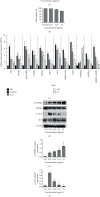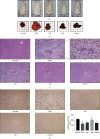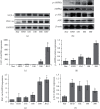Ulmus parvifolia Jacq. Exhibits Antiobesity Properties and Potentially Induces Browning of White Adipose Tissue
- PMID: 33425000
- PMCID: PMC7773463
- DOI: 10.1155/2020/9358563
Ulmus parvifolia Jacq. Exhibits Antiobesity Properties and Potentially Induces Browning of White Adipose Tissue
Abstract
The bark of Ulmus parvifolia Jacq. (UP) was traditionally used as a diuretic and to treat intestinal inflammation. With modern evidence of the correlation of diuretics, gut inflammation, and obesity, our study has shown the antiobesity effects of the bark of UP. UP treatment reduced lipid production and adipogenic genes in vitro. In vivo studies revealed that UP 100 mg/kg and UP 300 mg/kg treatment significantly reduced mouse weight without reducing food intake, indicating increased energy expenditure. UP significantly reduced the weight of epididymal and subcutaneous adipose tissue and decreased liver weight. Histological analysis revealed improvement in the progression of nonalcoholic fatty liver disease and epididymal white adipose tissue hypertrophy induced by a HFD. Real-Time PCR of epididymal adipose tissue revealed significant increases of uncoupling protein-1 (UCP-1) and peroxisome proliferator-activated receptor gamma coactivator 1-alpha (PGC-1α) expression after UP 300 mg/kg treatments. Phosphorylation of AMP-activated protein α (AMPKα) was increased, while phosphorylation of Acetyl-CoA Carboxylase (ACC) was reduced. Our findings reveal the ability of UP to reduce the occurrence of obesity through increased browning of white adipose tissue via increased AMPKα, PPARγ, PGC-1α, and UCP-1 expression.
Copyright © 2020 Yuan Yee Lee et al.
Conflict of interest statement
All authors declare no conflicts of interest.
Figures







References
-
- Santamour F. S., Jr., Bentz S. E. Updated checklist of elm (Ulmus) cultivars for use in North America. Journal of Arboriculture. 1995;21(3):122–131.
-
- Bate-Smith E. C., Richens R. H. Flavonoid chemistry and taxonomy in Ulmus. Biochemical Systematics and Ecology. 1973;1(3):141–146. doi: 10.1016/0305-1978(73)90004-5. - DOI
-
- Li C.-P. Chinese Herbal Medicine. Washington, DC, USA: US Department of Health, Education, and Welfare, Public Health Service, National Institute of Health; 1974.
-
- Vent W., Duke J. A., Ayensu E. S. Medicinal Plants of China. Vol. 2. Algonac, MI, USA: Reference Publ., Inc.; 1987.
LinkOut - more resources
Full Text Sources
Research Materials

